MGT603: Systems Thinking Assignment
VerifiedAdded on 2021/09/18
|10
|1837
|272
AI Summary
Contribute Materials
Your contribution can guide someone’s learning journey. Share your
documents today.
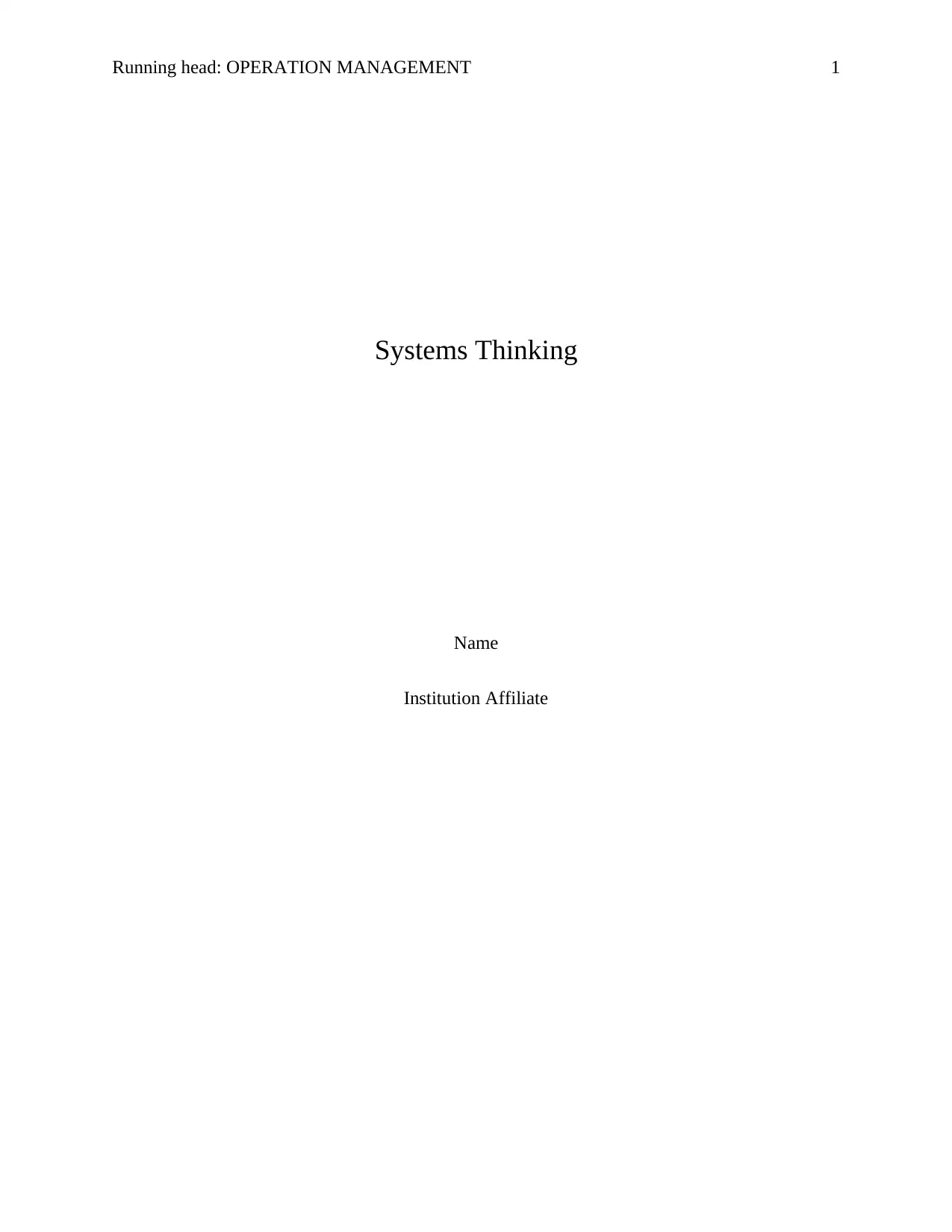
Running head: OPERATION MANAGEMENT 1
Systems Thinking
Name
Institution Affiliate
Systems Thinking
Name
Institution Affiliate
Secure Best Marks with AI Grader
Need help grading? Try our AI Grader for instant feedback on your assignments.
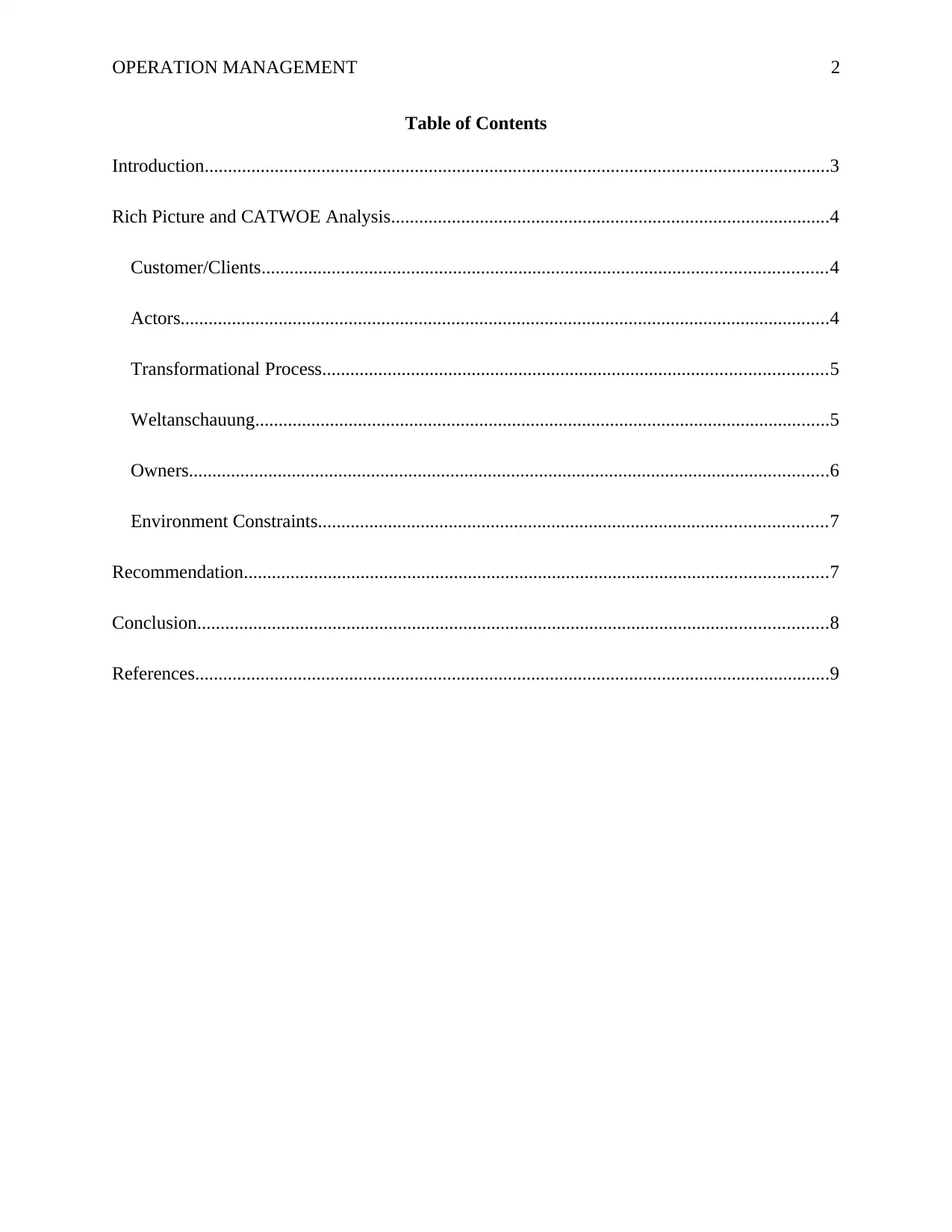
OPERATION MANAGEMENT 2
Table of Contents
Introduction......................................................................................................................................3
Rich Picture and CATWOE Analysis..............................................................................................4
Customer/Clients.........................................................................................................................4
Actors...........................................................................................................................................4
Transformational Process............................................................................................................5
Weltanschauung...........................................................................................................................5
Owners.........................................................................................................................................6
Environment Constraints.............................................................................................................7
Recommendation.............................................................................................................................7
Conclusion.......................................................................................................................................8
References........................................................................................................................................9
Table of Contents
Introduction......................................................................................................................................3
Rich Picture and CATWOE Analysis..............................................................................................4
Customer/Clients.........................................................................................................................4
Actors...........................................................................................................................................4
Transformational Process............................................................................................................5
Weltanschauung...........................................................................................................................5
Owners.........................................................................................................................................6
Environment Constraints.............................................................................................................7
Recommendation.............................................................................................................................7
Conclusion.......................................................................................................................................8
References........................................................................................................................................9
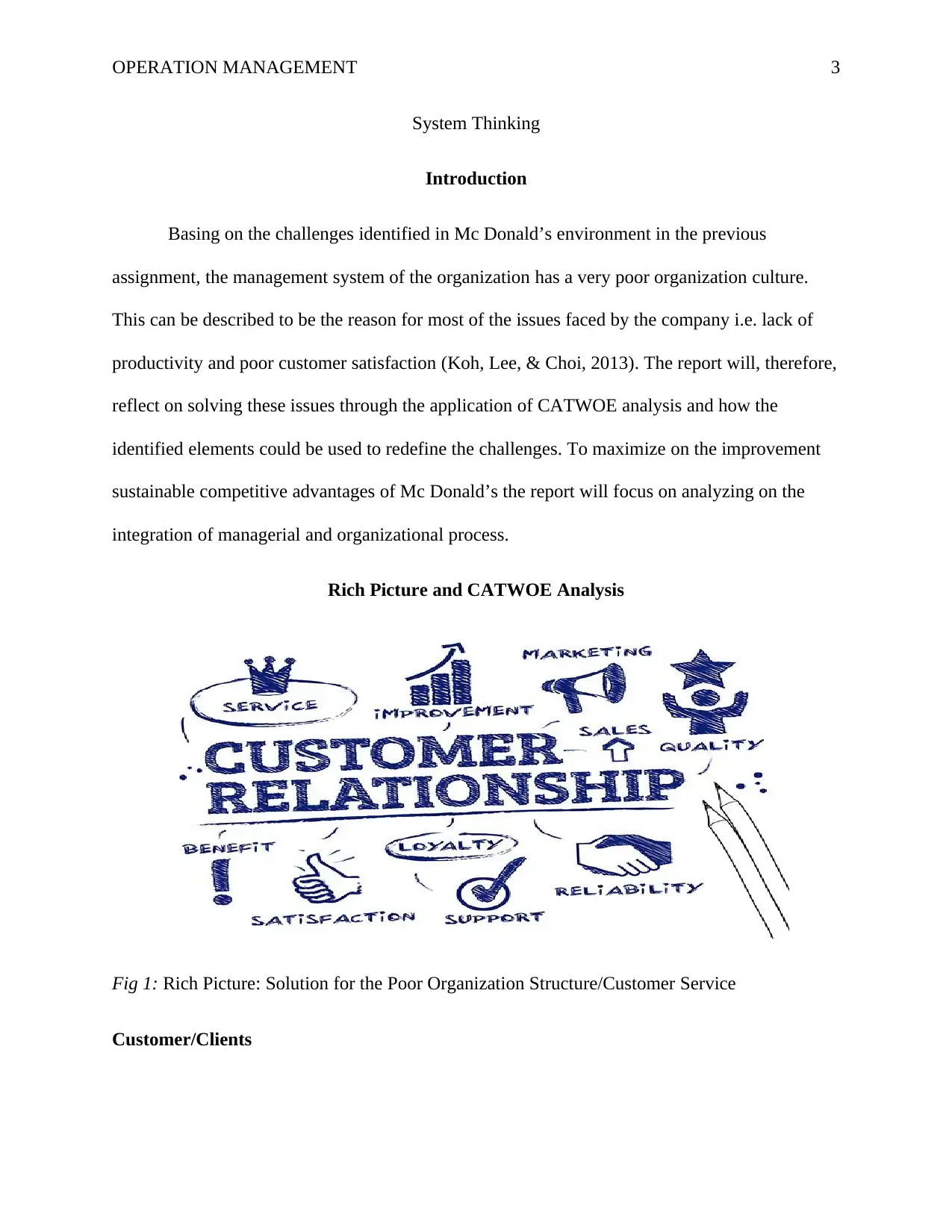
OPERATION MANAGEMENT 3
System Thinking
Introduction
Basing on the challenges identified in Mc Donald’s environment in the previous
assignment, the management system of the organization has a very poor organization culture.
This can be described to be the reason for most of the issues faced by the company i.e. lack of
productivity and poor customer satisfaction (Koh, Lee, & Choi, 2013). The report will, therefore,
reflect on solving these issues through the application of CATWOE analysis and how the
identified elements could be used to redefine the challenges. To maximize on the improvement
sustainable competitive advantages of Mc Donald’s the report will focus on analyzing on the
integration of managerial and organizational process.
Rich Picture and CATWOE Analysis
Fig 1: Rich Picture: Solution for the Poor Organization Structure/Customer Service
Customer/Clients
System Thinking
Introduction
Basing on the challenges identified in Mc Donald’s environment in the previous
assignment, the management system of the organization has a very poor organization culture.
This can be described to be the reason for most of the issues faced by the company i.e. lack of
productivity and poor customer satisfaction (Koh, Lee, & Choi, 2013). The report will, therefore,
reflect on solving these issues through the application of CATWOE analysis and how the
identified elements could be used to redefine the challenges. To maximize on the improvement
sustainable competitive advantages of Mc Donald’s the report will focus on analyzing on the
integration of managerial and organizational process.
Rich Picture and CATWOE Analysis
Fig 1: Rich Picture: Solution for the Poor Organization Structure/Customer Service
Customer/Clients
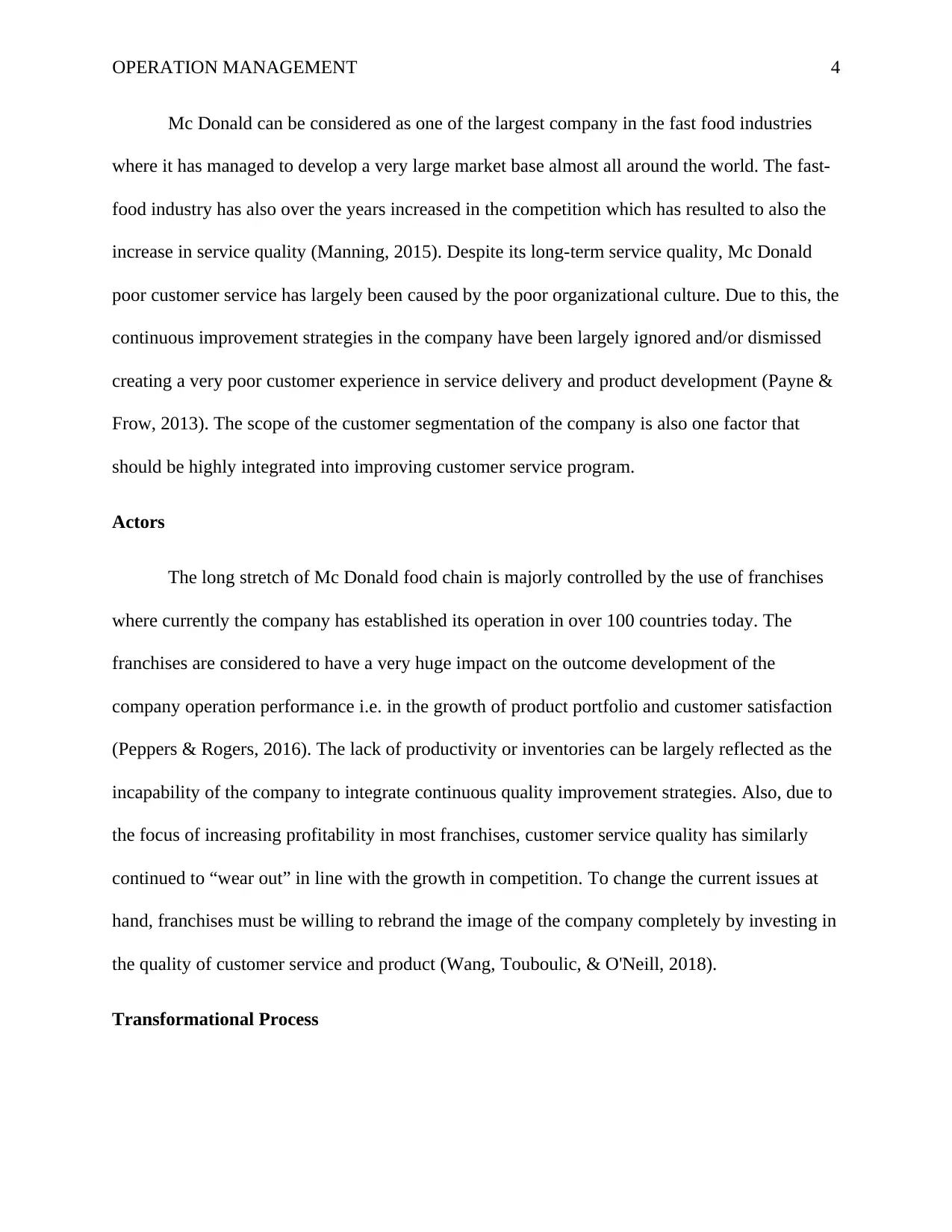
OPERATION MANAGEMENT 4
Mc Donald can be considered as one of the largest company in the fast food industries
where it has managed to develop a very large market base almost all around the world. The fast-
food industry has also over the years increased in the competition which has resulted to also the
increase in service quality (Manning, 2015). Despite its long-term service quality, Mc Donald
poor customer service has largely been caused by the poor organizational culture. Due to this, the
continuous improvement strategies in the company have been largely ignored and/or dismissed
creating a very poor customer experience in service delivery and product development (Payne &
Frow, 2013). The scope of the customer segmentation of the company is also one factor that
should be highly integrated into improving customer service program.
Actors
The long stretch of Mc Donald food chain is majorly controlled by the use of franchises
where currently the company has established its operation in over 100 countries today. The
franchises are considered to have a very huge impact on the outcome development of the
company operation performance i.e. in the growth of product portfolio and customer satisfaction
(Peppers & Rogers, 2016). The lack of productivity or inventories can be largely reflected as the
incapability of the company to integrate continuous quality improvement strategies. Also, due to
the focus of increasing profitability in most franchises, customer service quality has similarly
continued to “wear out” in line with the growth in competition. To change the current issues at
hand, franchises must be willing to rebrand the image of the company completely by investing in
the quality of customer service and product (Wang, Touboulic, & O'Neill, 2018).
Transformational Process
Mc Donald can be considered as one of the largest company in the fast food industries
where it has managed to develop a very large market base almost all around the world. The fast-
food industry has also over the years increased in the competition which has resulted to also the
increase in service quality (Manning, 2015). Despite its long-term service quality, Mc Donald
poor customer service has largely been caused by the poor organizational culture. Due to this, the
continuous improvement strategies in the company have been largely ignored and/or dismissed
creating a very poor customer experience in service delivery and product development (Payne &
Frow, 2013). The scope of the customer segmentation of the company is also one factor that
should be highly integrated into improving customer service program.
Actors
The long stretch of Mc Donald food chain is majorly controlled by the use of franchises
where currently the company has established its operation in over 100 countries today. The
franchises are considered to have a very huge impact on the outcome development of the
company operation performance i.e. in the growth of product portfolio and customer satisfaction
(Peppers & Rogers, 2016). The lack of productivity or inventories can be largely reflected as the
incapability of the company to integrate continuous quality improvement strategies. Also, due to
the focus of increasing profitability in most franchises, customer service quality has similarly
continued to “wear out” in line with the growth in competition. To change the current issues at
hand, franchises must be willing to rebrand the image of the company completely by investing in
the quality of customer service and product (Wang, Touboulic, & O'Neill, 2018).
Transformational Process
Secure Best Marks with AI Grader
Need help grading? Try our AI Grader for instant feedback on your assignments.
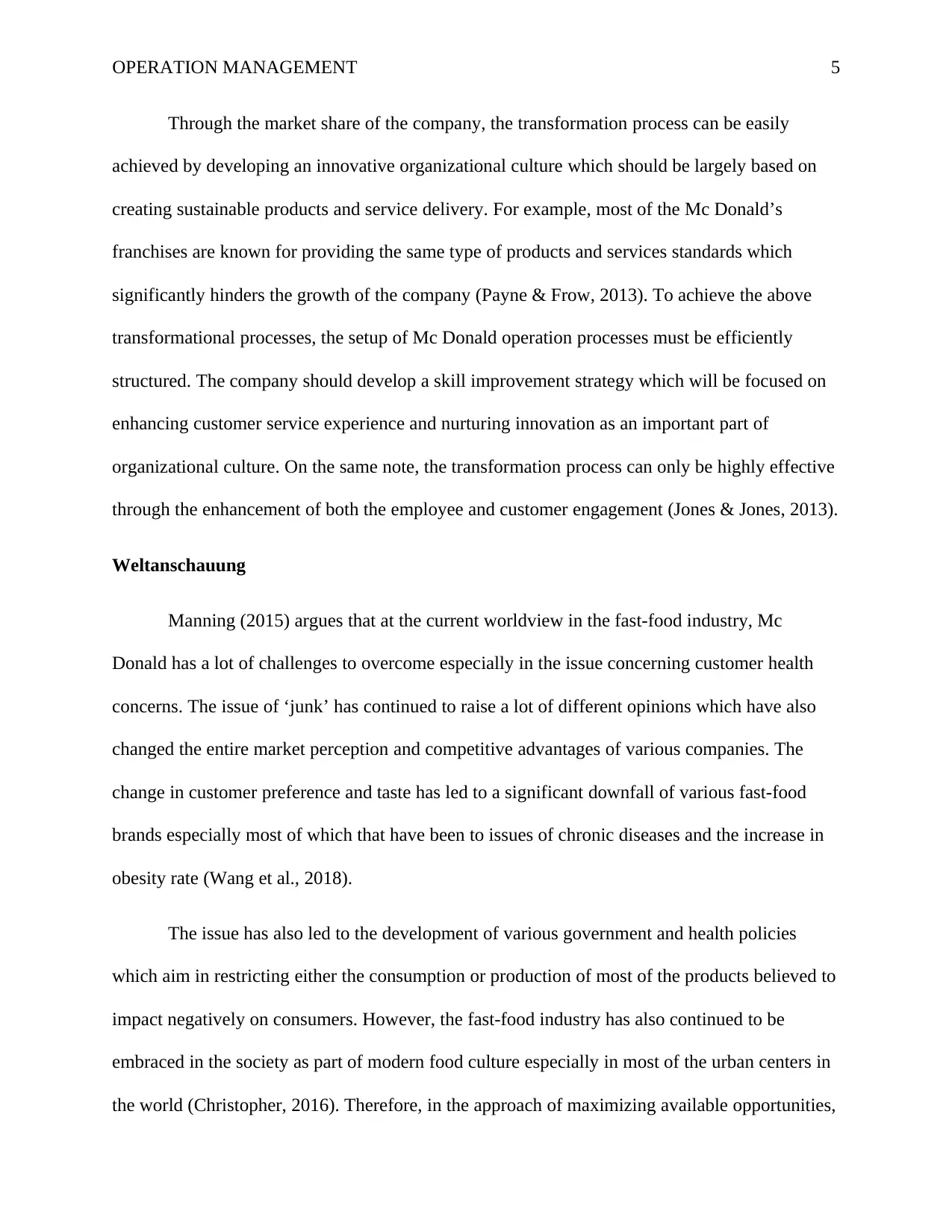
OPERATION MANAGEMENT 5
Through the market share of the company, the transformation process can be easily
achieved by developing an innovative organizational culture which should be largely based on
creating sustainable products and service delivery. For example, most of the Mc Donald’s
franchises are known for providing the same type of products and services standards which
significantly hinders the growth of the company (Payne & Frow, 2013). To achieve the above
transformational processes, the setup of Mc Donald operation processes must be efficiently
structured. The company should develop a skill improvement strategy which will be focused on
enhancing customer service experience and nurturing innovation as an important part of
organizational culture. On the same note, the transformation process can only be highly effective
through the enhancement of both the employee and customer engagement (Jones & Jones, 2013).
Weltanschauung
Manning (2015) argues that at the current worldview in the fast-food industry, Mc
Donald has a lot of challenges to overcome especially in the issue concerning customer health
concerns. The issue of ‘junk’ has continued to raise a lot of different opinions which have also
changed the entire market perception and competitive advantages of various companies. The
change in customer preference and taste has led to a significant downfall of various fast-food
brands especially most of which that have been to issues of chronic diseases and the increase in
obesity rate (Wang et al., 2018).
The issue has also led to the development of various government and health policies
which aim in restricting either the consumption or production of most of the products believed to
impact negatively on consumers. However, the fast-food industry has also continued to be
embraced in the society as part of modern food culture especially in most of the urban centers in
the world (Christopher, 2016). Therefore, in the approach of maximizing available opportunities,
Through the market share of the company, the transformation process can be easily
achieved by developing an innovative organizational culture which should be largely based on
creating sustainable products and service delivery. For example, most of the Mc Donald’s
franchises are known for providing the same type of products and services standards which
significantly hinders the growth of the company (Payne & Frow, 2013). To achieve the above
transformational processes, the setup of Mc Donald operation processes must be efficiently
structured. The company should develop a skill improvement strategy which will be focused on
enhancing customer service experience and nurturing innovation as an important part of
organizational culture. On the same note, the transformation process can only be highly effective
through the enhancement of both the employee and customer engagement (Jones & Jones, 2013).
Weltanschauung
Manning (2015) argues that at the current worldview in the fast-food industry, Mc
Donald has a lot of challenges to overcome especially in the issue concerning customer health
concerns. The issue of ‘junk’ has continued to raise a lot of different opinions which have also
changed the entire market perception and competitive advantages of various companies. The
change in customer preference and taste has led to a significant downfall of various fast-food
brands especially most of which that have been to issues of chronic diseases and the increase in
obesity rate (Wang et al., 2018).
The issue has also led to the development of various government and health policies
which aim in restricting either the consumption or production of most of the products believed to
impact negatively on consumers. However, the fast-food industry has also continued to be
embraced in the society as part of modern food culture especially in most of the urban centers in
the world (Christopher, 2016). Therefore, in the approach of maximizing available opportunities,
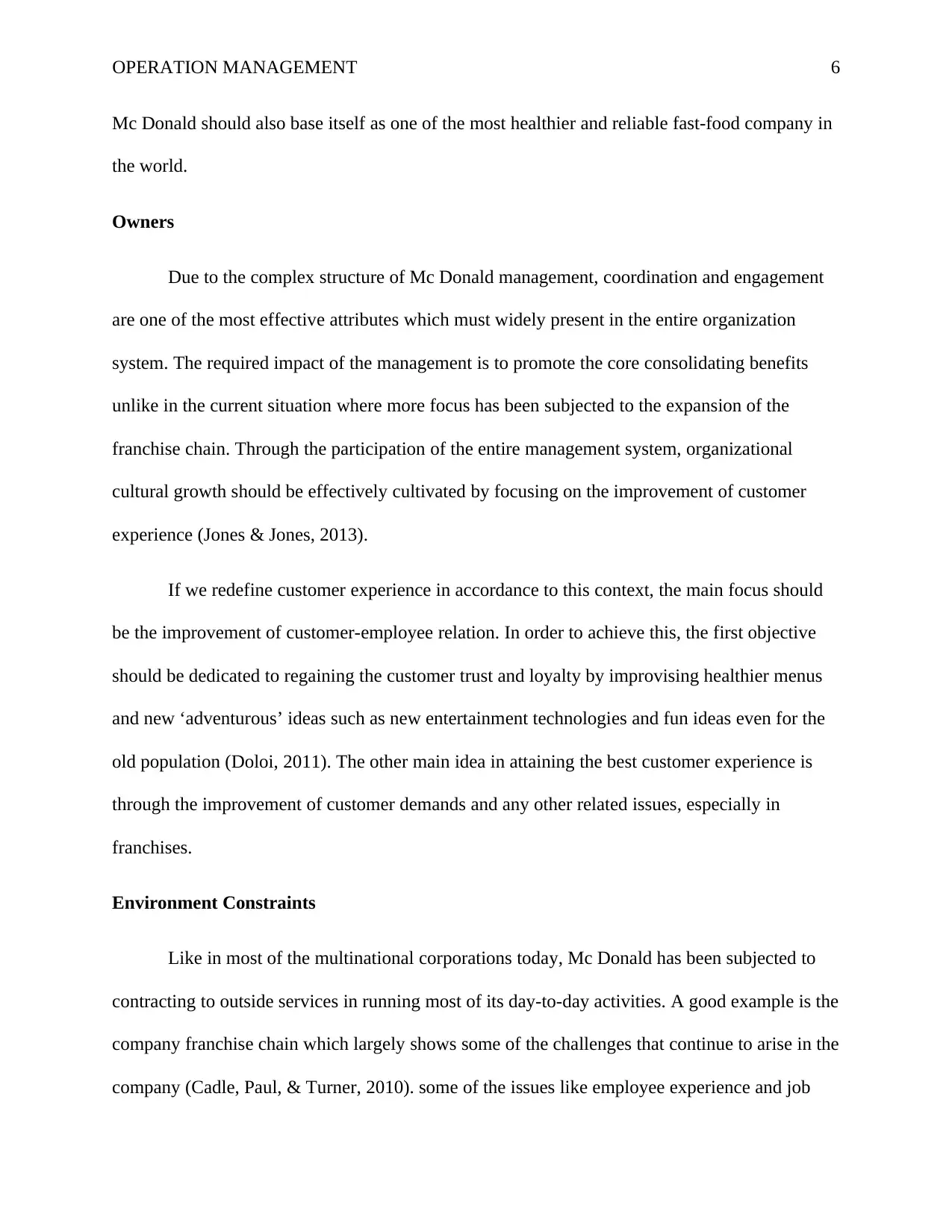
OPERATION MANAGEMENT 6
Mc Donald should also base itself as one of the most healthier and reliable fast-food company in
the world.
Owners
Due to the complex structure of Mc Donald management, coordination and engagement
are one of the most effective attributes which must widely present in the entire organization
system. The required impact of the management is to promote the core consolidating benefits
unlike in the current situation where more focus has been subjected to the expansion of the
franchise chain. Through the participation of the entire management system, organizational
cultural growth should be effectively cultivated by focusing on the improvement of customer
experience (Jones & Jones, 2013).
If we redefine customer experience in accordance to this context, the main focus should
be the improvement of customer-employee relation. In order to achieve this, the first objective
should be dedicated to regaining the customer trust and loyalty by improvising healthier menus
and new ‘adventurous’ ideas such as new entertainment technologies and fun ideas even for the
old population (Doloi, 2011). The other main idea in attaining the best customer experience is
through the improvement of customer demands and any other related issues, especially in
franchises.
Environment Constraints
Like in most of the multinational corporations today, Mc Donald has been subjected to
contracting to outside services in running most of its day-to-day activities. A good example is the
company franchise chain which largely shows some of the challenges that continue to arise in the
company (Cadle, Paul, & Turner, 2010). some of the issues like employee experience and job
Mc Donald should also base itself as one of the most healthier and reliable fast-food company in
the world.
Owners
Due to the complex structure of Mc Donald management, coordination and engagement
are one of the most effective attributes which must widely present in the entire organization
system. The required impact of the management is to promote the core consolidating benefits
unlike in the current situation where more focus has been subjected to the expansion of the
franchise chain. Through the participation of the entire management system, organizational
cultural growth should be effectively cultivated by focusing on the improvement of customer
experience (Jones & Jones, 2013).
If we redefine customer experience in accordance to this context, the main focus should
be the improvement of customer-employee relation. In order to achieve this, the first objective
should be dedicated to regaining the customer trust and loyalty by improvising healthier menus
and new ‘adventurous’ ideas such as new entertainment technologies and fun ideas even for the
old population (Doloi, 2011). The other main idea in attaining the best customer experience is
through the improvement of customer demands and any other related issues, especially in
franchises.
Environment Constraints
Like in most of the multinational corporations today, Mc Donald has been subjected to
contracting to outside services in running most of its day-to-day activities. A good example is the
company franchise chain which largely shows some of the challenges that continue to arise in the
company (Cadle, Paul, & Turner, 2010). some of the issues like employee experience and job
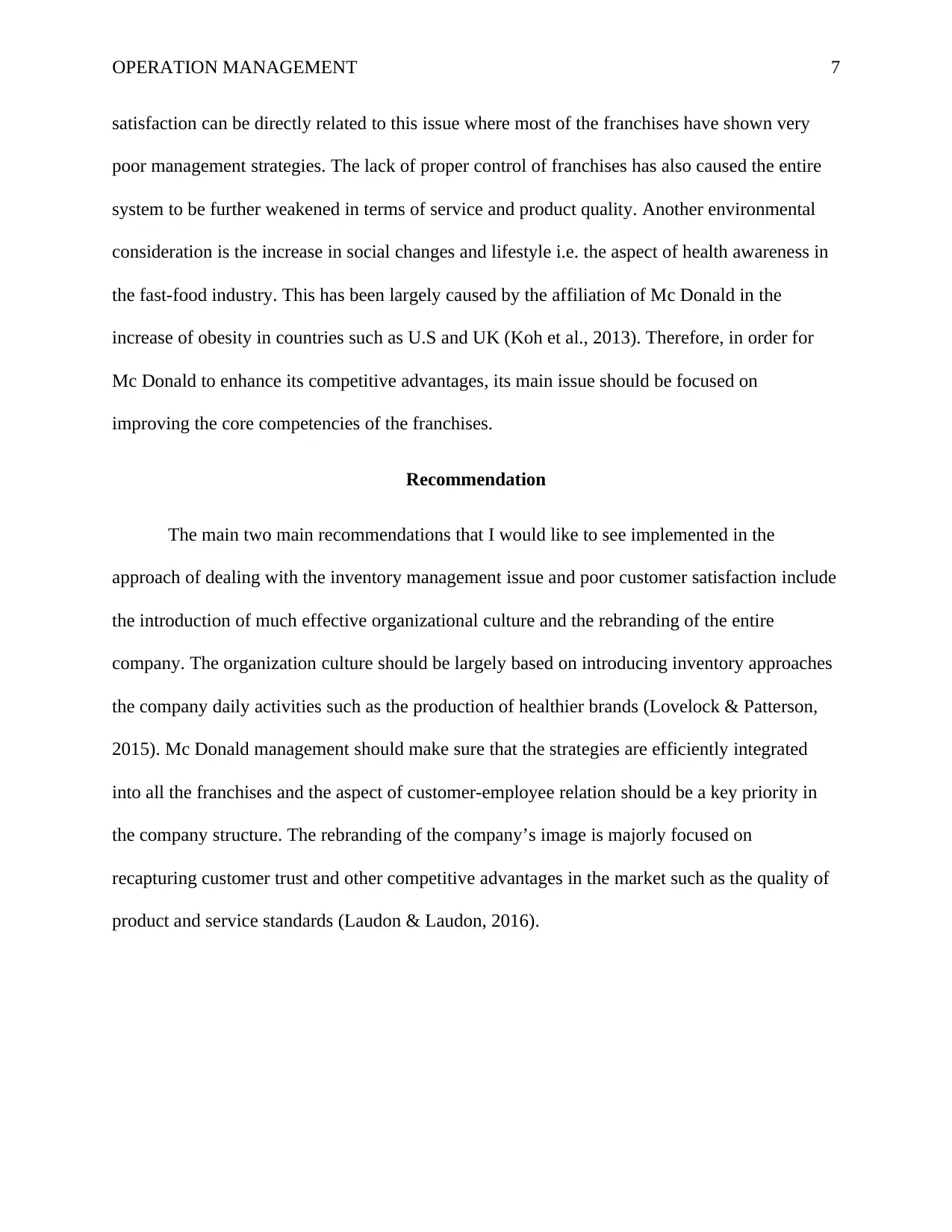
OPERATION MANAGEMENT 7
satisfaction can be directly related to this issue where most of the franchises have shown very
poor management strategies. The lack of proper control of franchises has also caused the entire
system to be further weakened in terms of service and product quality. Another environmental
consideration is the increase in social changes and lifestyle i.e. the aspect of health awareness in
the fast-food industry. This has been largely caused by the affiliation of Mc Donald in the
increase of obesity in countries such as U.S and UK (Koh et al., 2013). Therefore, in order for
Mc Donald to enhance its competitive advantages, its main issue should be focused on
improving the core competencies of the franchises.
Recommendation
The main two main recommendations that I would like to see implemented in the
approach of dealing with the inventory management issue and poor customer satisfaction include
the introduction of much effective organizational culture and the rebranding of the entire
company. The organization culture should be largely based on introducing inventory approaches
the company daily activities such as the production of healthier brands (Lovelock & Patterson,
2015). Mc Donald management should make sure that the strategies are efficiently integrated
into all the franchises and the aspect of customer-employee relation should be a key priority in
the company structure. The rebranding of the company’s image is majorly focused on
recapturing customer trust and other competitive advantages in the market such as the quality of
product and service standards (Laudon & Laudon, 2016).
satisfaction can be directly related to this issue where most of the franchises have shown very
poor management strategies. The lack of proper control of franchises has also caused the entire
system to be further weakened in terms of service and product quality. Another environmental
consideration is the increase in social changes and lifestyle i.e. the aspect of health awareness in
the fast-food industry. This has been largely caused by the affiliation of Mc Donald in the
increase of obesity in countries such as U.S and UK (Koh et al., 2013). Therefore, in order for
Mc Donald to enhance its competitive advantages, its main issue should be focused on
improving the core competencies of the franchises.
Recommendation
The main two main recommendations that I would like to see implemented in the
approach of dealing with the inventory management issue and poor customer satisfaction include
the introduction of much effective organizational culture and the rebranding of the entire
company. The organization culture should be largely based on introducing inventory approaches
the company daily activities such as the production of healthier brands (Lovelock & Patterson,
2015). Mc Donald management should make sure that the strategies are efficiently integrated
into all the franchises and the aspect of customer-employee relation should be a key priority in
the company structure. The rebranding of the company’s image is majorly focused on
recapturing customer trust and other competitive advantages in the market such as the quality of
product and service standards (Laudon & Laudon, 2016).
Paraphrase This Document
Need a fresh take? Get an instant paraphrase of this document with our AI Paraphraser

OPERATION MANAGEMENT 8
Fig 2: Market-Oriented Strategy
Conclusion
In summary, being one of the largest companies in the fast-food industry, Mc Donald
company has significantly failed in the aspect of integrating quality services and product as it
also continues to grow in the franchise chain. The company challenges have been contributed to
a number of reasons which largely comprise of the company dependence on outside services and
the increase in competition that has also caused the rise of quality demand in both the services
and products (Lovelock & Patterson, 2015). Through the implementation of the above
recommendation, I believe the company will be able to eliminate most of its currents challenges
in product and service delivery quality.
Fig 2: Market-Oriented Strategy
Conclusion
In summary, being one of the largest companies in the fast-food industry, Mc Donald
company has significantly failed in the aspect of integrating quality services and product as it
also continues to grow in the franchise chain. The company challenges have been contributed to
a number of reasons which largely comprise of the company dependence on outside services and
the increase in competition that has also caused the rise of quality demand in both the services
and products (Lovelock & Patterson, 2015). Through the implementation of the above
recommendation, I believe the company will be able to eliminate most of its currents challenges
in product and service delivery quality.
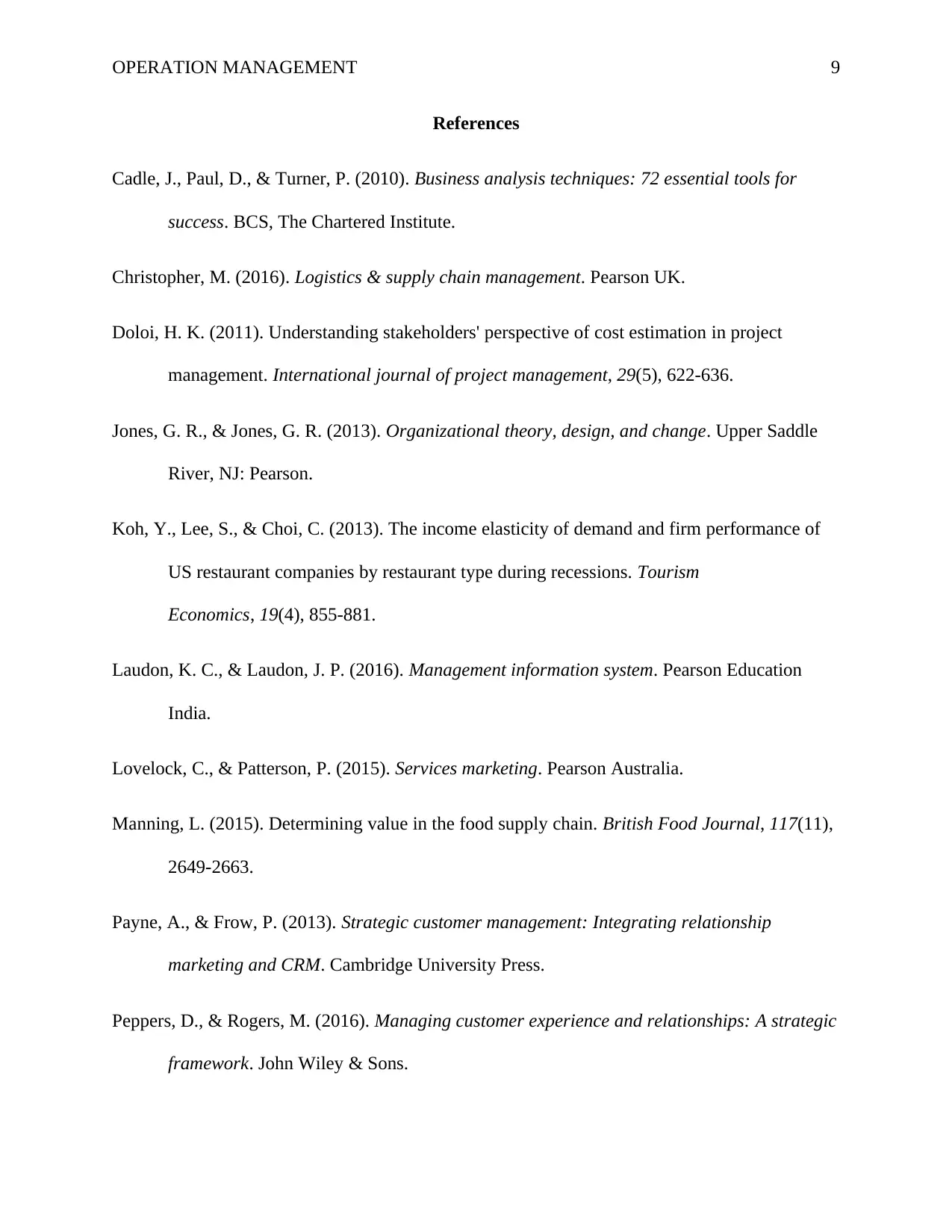
OPERATION MANAGEMENT 9
References
Cadle, J., Paul, D., & Turner, P. (2010). Business analysis techniques: 72 essential tools for
success. BCS, The Chartered Institute.
Christopher, M. (2016). Logistics & supply chain management. Pearson UK.
Doloi, H. K. (2011). Understanding stakeholders' perspective of cost estimation in project
management. International journal of project management, 29(5), 622-636.
Jones, G. R., & Jones, G. R. (2013). Organizational theory, design, and change. Upper Saddle
River, NJ: Pearson.
Koh, Y., Lee, S., & Choi, C. (2013). The income elasticity of demand and firm performance of
US restaurant companies by restaurant type during recessions. Tourism
Economics, 19(4), 855-881.
Laudon, K. C., & Laudon, J. P. (2016). Management information system. Pearson Education
India.
Lovelock, C., & Patterson, P. (2015). Services marketing. Pearson Australia.
Manning, L. (2015). Determining value in the food supply chain. British Food Journal, 117(11),
2649-2663.
Payne, A., & Frow, P. (2013). Strategic customer management: Integrating relationship
marketing and CRM. Cambridge University Press.
Peppers, D., & Rogers, M. (2016). Managing customer experience and relationships: A strategic
framework. John Wiley & Sons.
References
Cadle, J., Paul, D., & Turner, P. (2010). Business analysis techniques: 72 essential tools for
success. BCS, The Chartered Institute.
Christopher, M. (2016). Logistics & supply chain management. Pearson UK.
Doloi, H. K. (2011). Understanding stakeholders' perspective of cost estimation in project
management. International journal of project management, 29(5), 622-636.
Jones, G. R., & Jones, G. R. (2013). Organizational theory, design, and change. Upper Saddle
River, NJ: Pearson.
Koh, Y., Lee, S., & Choi, C. (2013). The income elasticity of demand and firm performance of
US restaurant companies by restaurant type during recessions. Tourism
Economics, 19(4), 855-881.
Laudon, K. C., & Laudon, J. P. (2016). Management information system. Pearson Education
India.
Lovelock, C., & Patterson, P. (2015). Services marketing. Pearson Australia.
Manning, L. (2015). Determining value in the food supply chain. British Food Journal, 117(11),
2649-2663.
Payne, A., & Frow, P. (2013). Strategic customer management: Integrating relationship
marketing and CRM. Cambridge University Press.
Peppers, D., & Rogers, M. (2016). Managing customer experience and relationships: A strategic
framework. John Wiley & Sons.
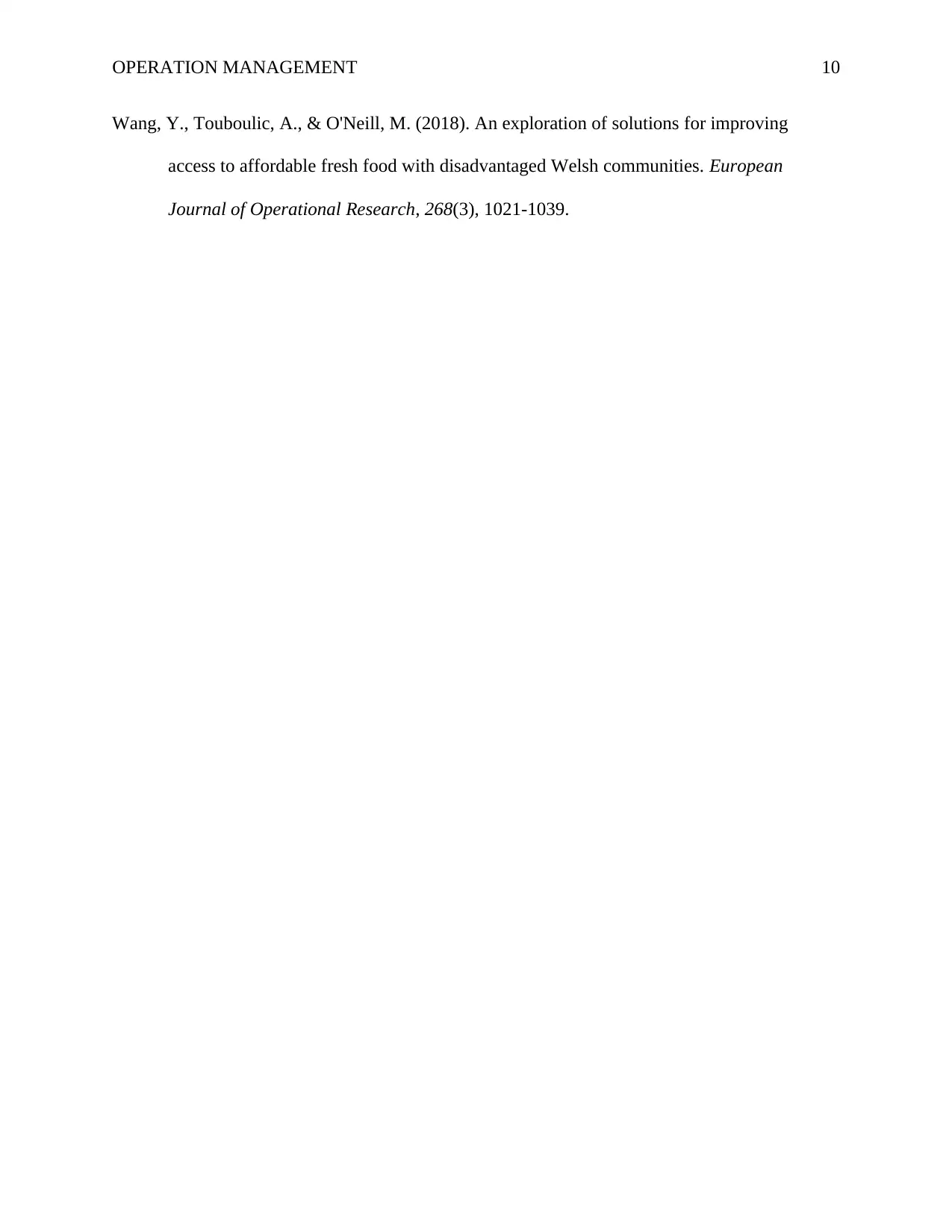
OPERATION MANAGEMENT 10
Wang, Y., Touboulic, A., & O'Neill, M. (2018). An exploration of solutions for improving
access to affordable fresh food with disadvantaged Welsh communities. European
Journal of Operational Research, 268(3), 1021-1039.
Wang, Y., Touboulic, A., & O'Neill, M. (2018). An exploration of solutions for improving
access to affordable fresh food with disadvantaged Welsh communities. European
Journal of Operational Research, 268(3), 1021-1039.
1 out of 10
Related Documents
Your All-in-One AI-Powered Toolkit for Academic Success.
+13062052269
info@desklib.com
Available 24*7 on WhatsApp / Email
![[object Object]](/_next/static/media/star-bottom.7253800d.svg)
Unlock your academic potential
© 2024 | Zucol Services PVT LTD | All rights reserved.





